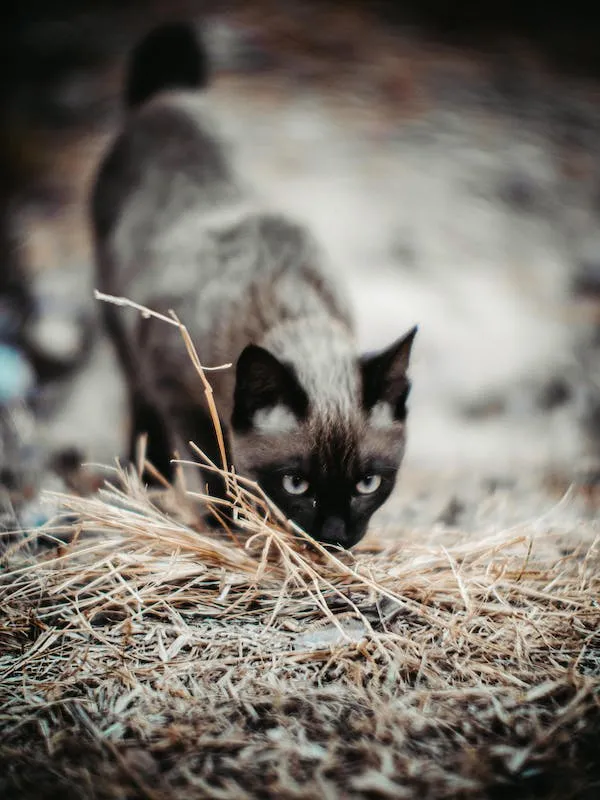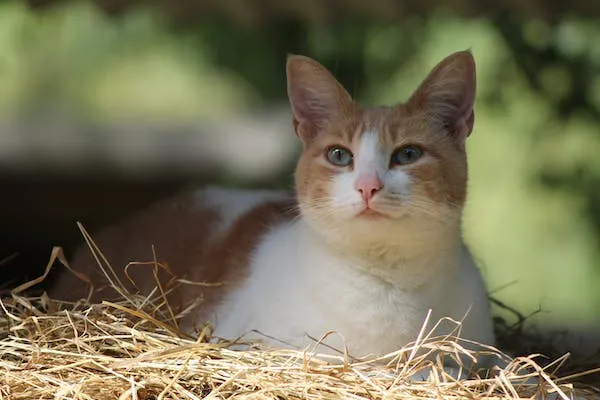we are committed to providing comprehensive and reliable information about feline nutrition. In this article, we will delve into the topic of whether cats can eat hay and explore the potential benefits and considerations associated with it. While cats are obligate carnivores, meaning their diet primarily consists of meat, there are certain scenarios where incorporating hay into their diet may be advantageous. Let’s explore this further.

Understanding the Role of Hay in a Cat’s Diet
The Digestive System of Cats
Before diving into whether cats can eat hay, it’s crucial to understand their unique digestive system. Cats have a shorter digestive tract compared to herbivores, like cows or horses, which allows them to efficiently process and absorb nutrients from animal-based protein sources. Their digestive system is not well-adapted to digesting large quantities of plant matter.
Hay as a Source of Fiber
Hay primarily serves as a source of dietary fiber for herbivores. Fiber aids in digestion, promotes gut health, and prevents constipation. However, cats have a limited ability to digest fiber due to the lack of certain enzymes necessary for breaking down plant material. While cats don’t require fiber in the same way as herbivores, there are situations where small amounts of hay can be beneficial.
Instances Where Cats May Benefit from Hay
Hairball Prevention
Cats are meticulous groomers, and as a result, they may ingest a significant amount of fur. This can lead to the formation of hairballs in their digestive system. Offering a small amount of hay to cats can help facilitate the passage of fur through their intestinal tract. The hay acts as a natural fiber supplement, aiding in the elimination of hairballs.
Environmental Enrichment
Cats are curious animals that benefit from mental and physical stimulation. Providing them with hay can serve as an environmental enrichment tool. It allows them to engage in natural behaviors such as exploring, foraging, and nibbling. This can contribute to their overall well-being and provide a form of entertainment.
Precautions and Considerations

While incorporating hay into a cat’s diet can have potential benefits, there are several important considerations to keep in mind:
Quality and Safety
When offering hay to cats, it’s crucial to ensure its quality and safety. Opt for organic, pesticide-free hay that is specifically intended for small animals. Avoid hay that may have been treated with chemicals or fertilizers that could be harmful to cats.
Moderation is Key
Hay should only be given to cats in small quantities as an occasional treat or environmental enrichment tool. It should never replace their primary diet, which should consist of high-quality commercial cat food that meets their nutritional requirements.
Conclusion
In conclusion, while cats are obligate carnivores and their main diet should consist of animal-based protein sources, there are situations where incorporating hay can be beneficial. It can aid in hairball prevention and provide environmental enrichment for cats. However, it’s essential to exercise caution, ensuring the hay is of high quality and only offered in moderation. As with any dietary changes, consulting with a veterinarian is advisable to ensure the health and well-being of your feline companion.
Remember, we strive to provide accurate and informative content for cat owners seeking the best care and nutrition for their beloved pets.
What Cat Food Can Hedgehogs Eat: A Comprehensive Guide

